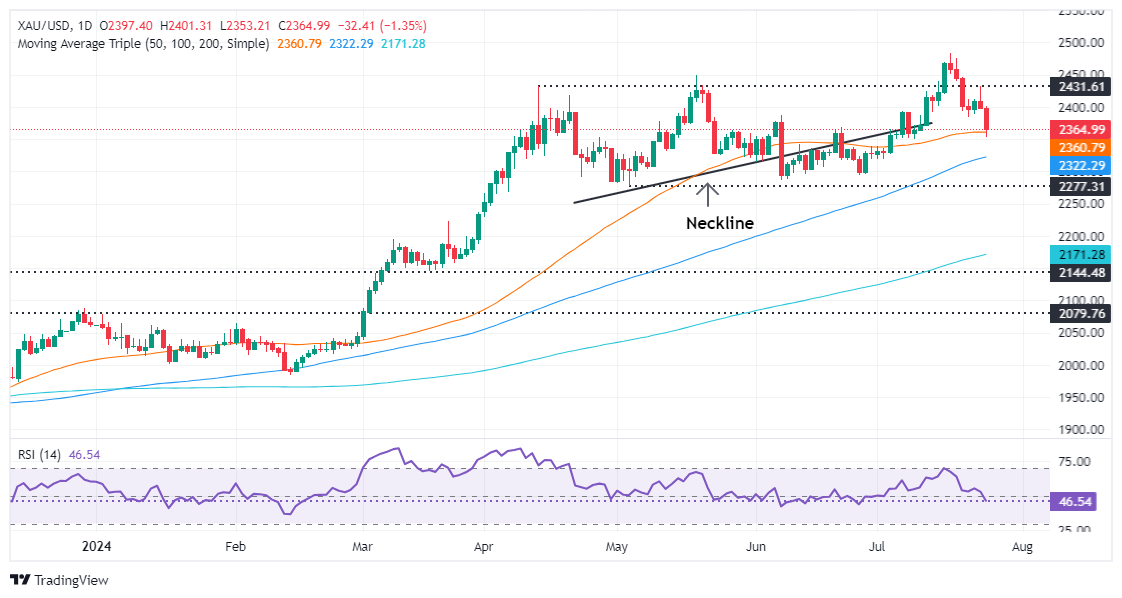Gold sinks to two-week low despite falling US yields
|
- Gold prices fall 5% from July 17 peak of $2,483 to $2,364.
- US Q2 GDP beats expectations, strengthening the US Dollar and impacting gold.
- Market certainty grows for a Fed rate cut in September as Treasury yields decline.
Gold price tumbled to a two-week low on Thursday after the US Bureau of Economic Analysis reported that the economy in the United States (US) fared better than expected in the second quarter of 2024. This weighed on the precious metal, which lost over 1.30%, and XAU/USD trades at $2,364 at the time of writing.
Bullion prices hit their highest level on July 17, at $2,483; since then, they have fallen about 5% toward the current spot price. XAY/USD’s fall is mostly attributed to profit-taking as US Treasury yields also dropped while the Greenback remained firm.
US data revealed that the Gross Domestic Product in Q2 was better than expected, crushing the first-quarter numbers. Meanwhile, the number of Americans filing for unemployment benefits dipped compared to the week ending July 30. Durable Goods Orders contracted more than -6%, though excluding aircraft and transport, they recovered from May’s drop.
Despite all that, the US 10-year Treasury note coupon edged lower by more than four basis points (bps) and ended at 4.245% on Thursday. According to the CME FedWatch Tool data, investors seem 100% certain that the Federal Reserve will slash interest rates a quarter of a percentage point at the September meeting.
Daily digest market movers: Gold price on the backfoot as US GDP advances
- US GDP for Q2 2024 jumped from 1.4% to 2.8% QoQ, exceeding forecasts of 2% on its advance reading.
- US Initial Jobless Claims for the week ending July 20 rose by 235K, less than the estimated 238K and lower than the previous week's 245K.
- US Durable Goods Orders plummeted by -6.6% MoM in June, significantly below the estimated 0.3%. However, Core Durable Goods, which excludes aircraft, expanded by 0.5% MoM, up from -0.1% and above the consensus projection of 0.2%.
- The Fed’s preferred measure of inflation, the Core PCE, is expected to dip from 2.6% to 2.5% year-over-year (YoY).
Technical analysis: Gold price falls below $2,400 with sellers eyeing $2,300
Bullion extended its losses once it achieved a daily close below $2,400 on Wednesday, which exacerbated a drop to familiar levels. Short-term momentum favors sellers, as portrayed by the Relative Strength Index (RSI), which just pierced the 50-neutral line.
Therefore, the XAU/USD might continue to edge lower. If sellers drag prices below the 50-day moving average (DMA) at $2,359, the next support would be the July 25 daily low of $2,353. Once those levels are removed, the 100-DMA would be up next at $2,324, ahead of diving to the $2,300 mark.
Conversely, buyers need to clear the $2,400 figure to test the all-time high (ATH) at around $2,483.
Economic Indicator
Personal Consumption Expenditures - Price Index (YoY)
The Personal Consumption Expenditures (PCE), released by the US Bureau of Economic Analysis on a monthly basis, measures the changes in the prices of goods and services purchased by consumers in the United States (US). The YoY reading compares prices in the reference month to a year earlier. Price changes may cause consumers to switch from buying one good to another and the PCE Deflator can account for such substitutions. This makes it the preferred measure of inflation for the Federal Reserve. Generally, a high reading is bullish for the US Dollar (USD), while a low reading is bearish.
Read more.Next release: Fri Jul 26, 2024 12:30
Frequency: Monthly
Consensus: 2.5%
Previous: 2.6%
Source: US Bureau of Economic Analysis
Information on these pages contains forward-looking statements that involve risks and uncertainties. Markets and instruments profiled on this page are for informational purposes only and should not in any way come across as a recommendation to buy or sell in these assets. You should do your own thorough research before making any investment decisions. FXStreet does not in any way guarantee that this information is free from mistakes, errors, or material misstatements. It also does not guarantee that this information is of a timely nature. Investing in Open Markets involves a great deal of risk, including the loss of all or a portion of your investment, as well as emotional distress. All risks, losses and costs associated with investing, including total loss of principal, are your responsibility. The views and opinions expressed in this article are those of the authors and do not necessarily reflect the official policy or position of FXStreet nor its advertisers.
